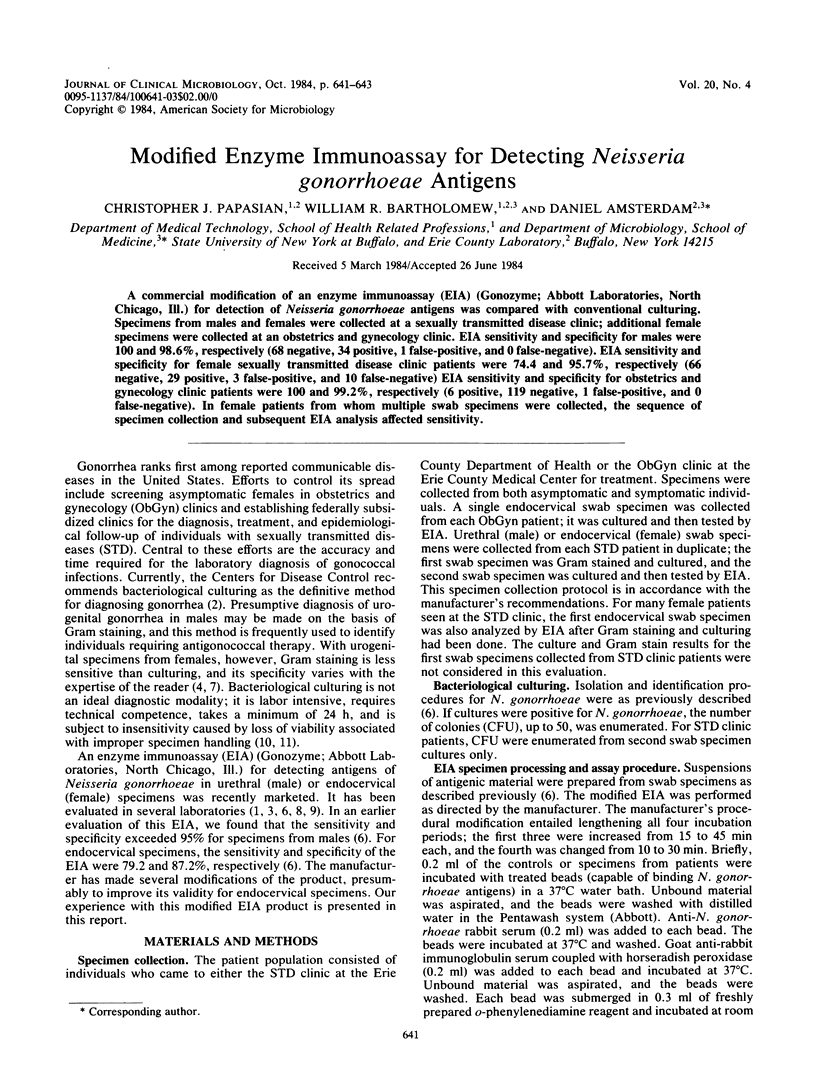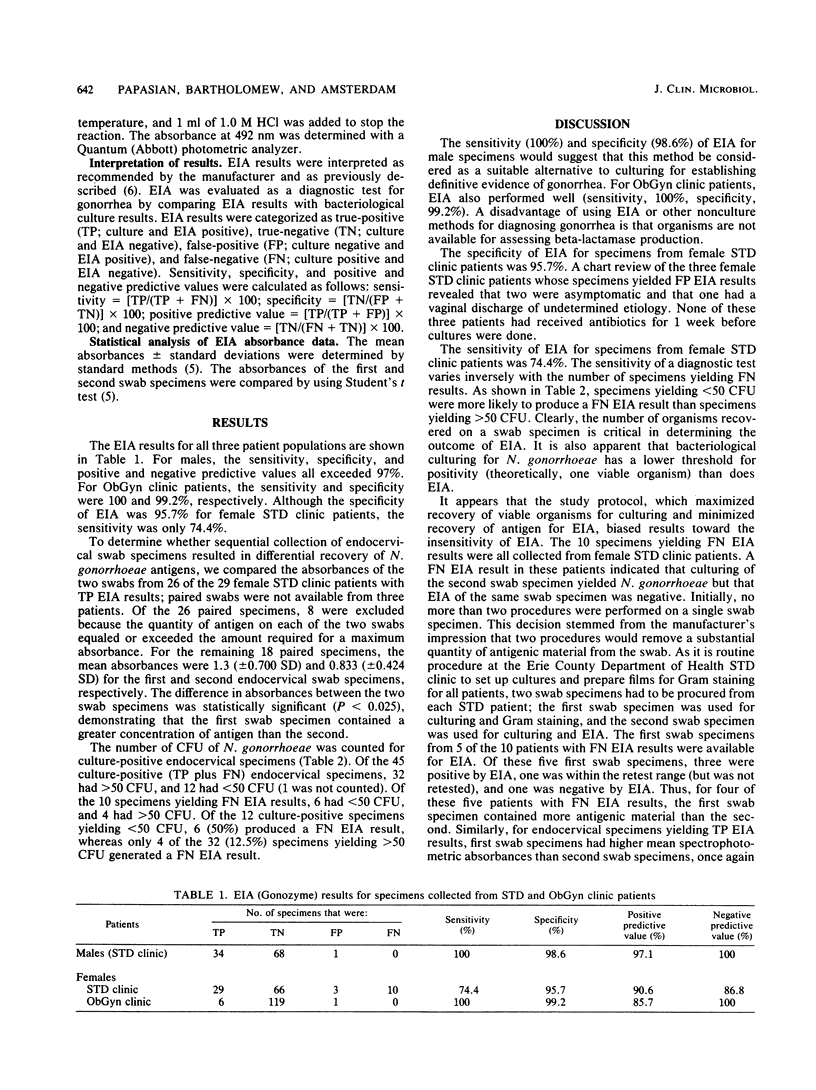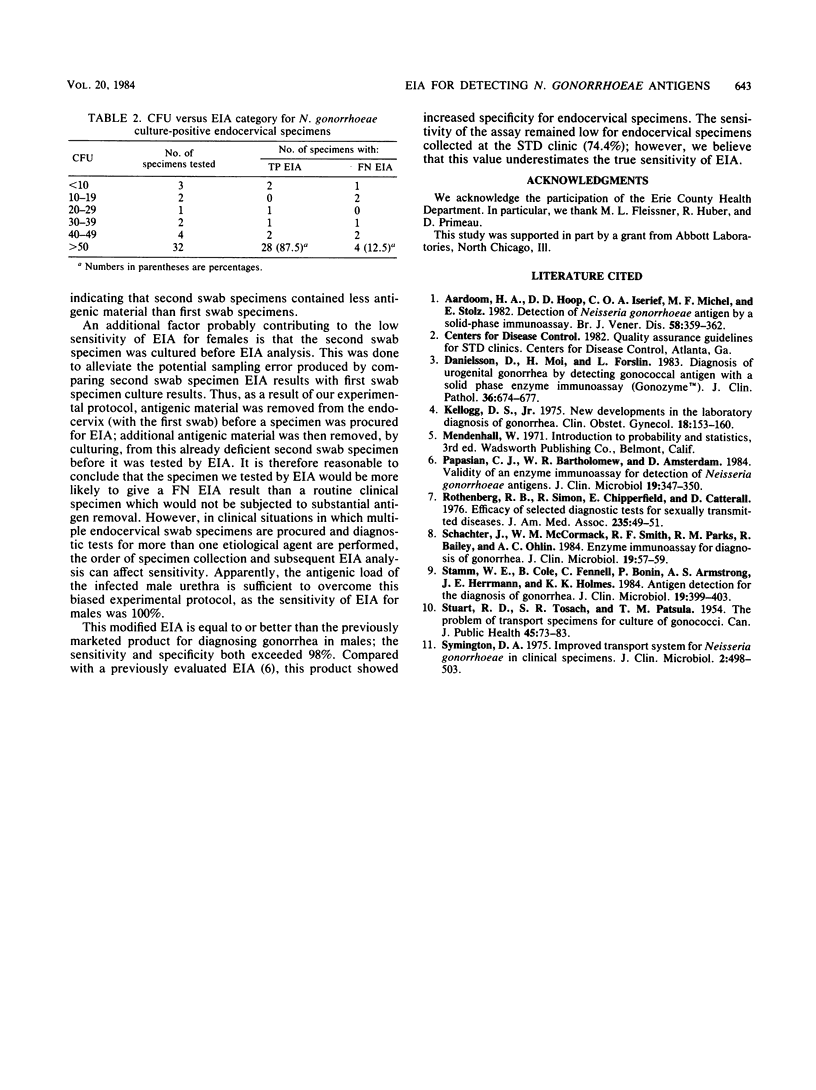Abstract
A commercial modification of an enzyme immunoassay (EIA) (Gonozyme; Abbott Laboratories, North Chicago, Ill.) for detection of Neisseria gonorrhoeae antigens was compared with conventional culturing. Specimens from males and females were collected at a sexually transmitted disease clinic; additional female specimens were collected at an obstetrics and gynecology clinic. EIA sensitivity and specificity for males were 100 and 98.6%, respectively (68 negative, 34 positive, 1 false-positive, and 0 false-negative). EIA sensitivity and specificity for female sexually transmitted disease clinic patients were 74.4 and 95.7%, respectively (66 negative, 29 positive, 3 false-positive, and 10 false-negative) EIA sensitivity and specificity for obstetrics and gynecology clinic patients were 100 and 99.2%, respectively (6 positive, 119 negative, 1 false-positive, and 0 false-negative). In female patients from whom multiple swab specimens were collected, the sequence of specimen collection and subsequent EIA analysis affected sensitivity.
Full text
PDF


Selected References
These references are in PubMed. This may not be the complete list of references from this article.
- Aardoom H. A., de Hoop D., Iserief C. O., Michel M. F., Stolz E. Detection of Neisseria gonorrhoeae antigen by a solid-phase enzyme immunoassay. Br J Vener Dis. 1982 Dec;58(6):359–362. doi: 10.1136/sti.58.6.359. [DOI] [PMC free article] [PubMed] [Google Scholar]
- Danielsson D., Moi H., Forslin L. Diagnosis of urogenital gonorrhoea by detecting gonococcal antigen with a solid phase enzyme immunoassay (Gonozyme). J Clin Pathol. 1983 Jun;36(6):674–677. doi: 10.1136/jcp.36.6.674. [DOI] [PMC free article] [PubMed] [Google Scholar]
- Kellogg D. S., Jr New developments in the laboratory diagnosis of gonorrhea. Clin Obstet Gynecol. 1975 Mar;18(1):153–160. doi: 10.1097/00003081-197503000-00014. [DOI] [PubMed] [Google Scholar]
- Papasian C. J., Bartholomew W. R., Amsterdam D. Validity of an enzyme immunoassay for detection of Neisseria gonorrhoeae antigens. J Clin Microbiol. 1984 Mar;19(3):347–350. doi: 10.1128/jcm.19.3.347-350.1984. [DOI] [PMC free article] [PubMed] [Google Scholar]
- Rothenberg R. B., Simon R., Chipperfield E., Catterall R. D. Efficacy of selected diagnostic tests for sexually transmitted diseases. JAMA. 1976 Jan 5;235(1):49–51. [PubMed] [Google Scholar]
- STUART R. D., TOSHACH S. R., PATSULA T. M. The problem of transport of specimens for culture of Gonococci. Can J Public Health. 1954 Feb;45(2):73–83. [PubMed] [Google Scholar]
- Schachter J., McCormack W. M., Smith R. F., Parks R. M., Bailey R., Ohlin A. C. Enzyme immunoassay for diagnosis of gonorrhea. J Clin Microbiol. 1984 Jan;19(1):57–59. doi: 10.1128/jcm.19.1.57-59.1984. [DOI] [PMC free article] [PubMed] [Google Scholar]
- Stamm W. E., Cole B., Fennell C., Bonin P., Armstrong A. S., Herrmann J. E., Holmes K. K. Antigen detection for the diagnosis of gonorrhea. J Clin Microbiol. 1984 Mar;19(3):399–403. doi: 10.1128/jcm.19.3.399-403.1984. [DOI] [PMC free article] [PubMed] [Google Scholar]
- Symington D. A. Improved transport system for Neisseria gonorrhoeae in clinical specimens. J Clin Microbiol. 1975 Dec;2(6):498–503. doi: 10.1128/jcm.2.6.498-503.1975. [DOI] [PMC free article] [PubMed] [Google Scholar]


